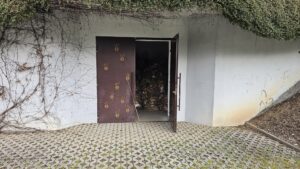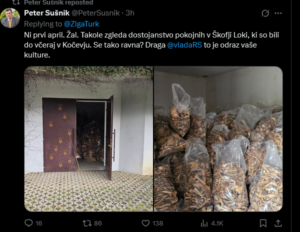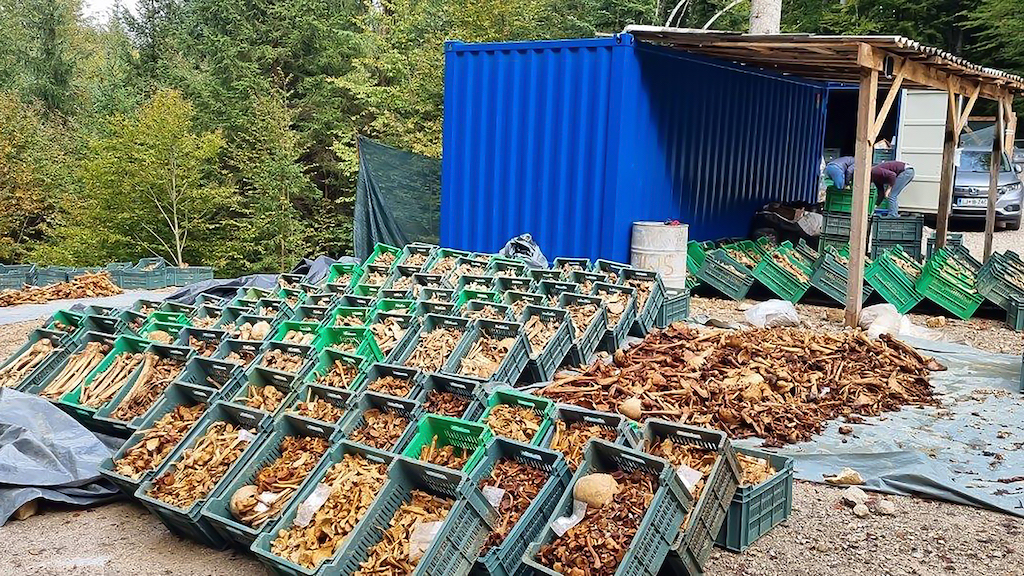By: Moja Dolenjska
On Monday morning, the ruling coalition (Svoboda, SD, and Levica) began the transfer of mortal remains from the post-war burial site Jama pod Macesnovo Gorico from the basement of the Kočevje municipal utility to the state ossuary in Škofja Loka. According to the President of the Republic, Nataša Pirc Musar, who participated in the activities, this should ensure a temporary dignified storage of the victims of post-war killings until a permanent burial site is determined.
But is the temporary storage truly dignified?
As the Minister of Defence, Borut Sajovic, stated in a media statement, the mortal remains of the victims exhumed from Jama pod Macesnovo Gorico had been temporarily stored in unsuitable basement premises of the Kočevje municipal utility. The surroundings of the ossuary, built in 2009 at the Lipce cemetery for this purpose, have been arranged according to customary practices. “There, it is possible to light candles and respectfully remember,” he said.
However, those who have been involved in uncovering post-war execution sites of the Slovenian revolutionary authorities in recent years warn that the spaces where the bones are being transferred are far from suitable and dignified. As proof, they provided photographs showing that the bones of the slain were crammed into transparent industrial bags, which were then stacked on top of each other and placed in one of the ossuary’s rooms.

The decision to transfer the mortal remains to Škofja Loka is not supported even by the government commission for addressing the issue of concealed mass graves, led by Jože Dežman. As Dežman wrote, at last year’s meeting with the President of the Republic, the relatives of the deceased and representatives of the Catholic Church unanimously opposed the transfer of the remains from one temporary location to another until a final decision is made regarding the place, manner, and time of permanent burial.
Many believe that the most appropriate burial site would be Ljubljana’s central cemetery at Žale, where other war victims and soldiers of various nationalities, including occupying forces, have already been buried. However, Ljubljana’s mayor, Zoran Janković, has opposed this for years.
One encouraging stance comes from President Pirc Musar, who repeatedly emphasised on Monday that the post-war killings were a crime that must be unequivocally condemned. She hopes that by the 80th anniversary of the end of World War II, reconciliation can finally be achieved regarding this dark chapter of history, along with an agreement on a permanent burial site for the victims of war violence and post-war executions.
Excavations under Macesnova Gorica in the Kočevski Rog began in May 2022, following years of preparation and research. By the time the work was completed, approximately 3,000 cubic meters of material had been excavated. In addition to skeletal remains, many various objects were discovered, Dežman stated in his 2022 presentation of the excavation findings.
The excavation was led by Luka Rozman, who described it as a complex project involving construction, archaeology, and anthropology. The work was further complicated by the presence of several hundred unexploded munitions, which had to be detected and removed in a timely manner to ensure safety.
According to government commission member Mitja Ferenc, research indicates that the victims in the mass grave were predominantly Slovenes. Unlike other similar execution sites, many crosses of Our Lady of Brezje were found in the pit, suggesting that most of the victims were Slovenian.
Rozman explained that the victims were brought to the edge of the pit, where they were shot and pushed into the 16-meter-deep chasm. Around 40 victims survived the shooting and the fall but were unable to escape. However, some managed to survive and later testified about the events.
Numerous shell casings, bullets, clothing, footwear, and even crutches were also found in the pit. According to Rozman, this suggests that many of the executed were wounded individuals.
“The mass grave under Macesnova Gorica should serve as both a memory and a warning that what happened after World War II must never be repeated among Slovenians, regardless of the challenges we may face as a nation,” Ferenc urged. After nearly 80 years, he believes it is time to overcome differing perspectives and grant the victims a dignified burial.
Since the site contains predominantly Slovenian victims, Ferenc suggests that the annual commemorative ceremonies, currently held a few kilometres away at the mass grave under Kren, should be relocated to the site at Macesnova Gorica. According to current research, the Kren mass grave mainly contains victims from other nations of the former Yugoslavia.


